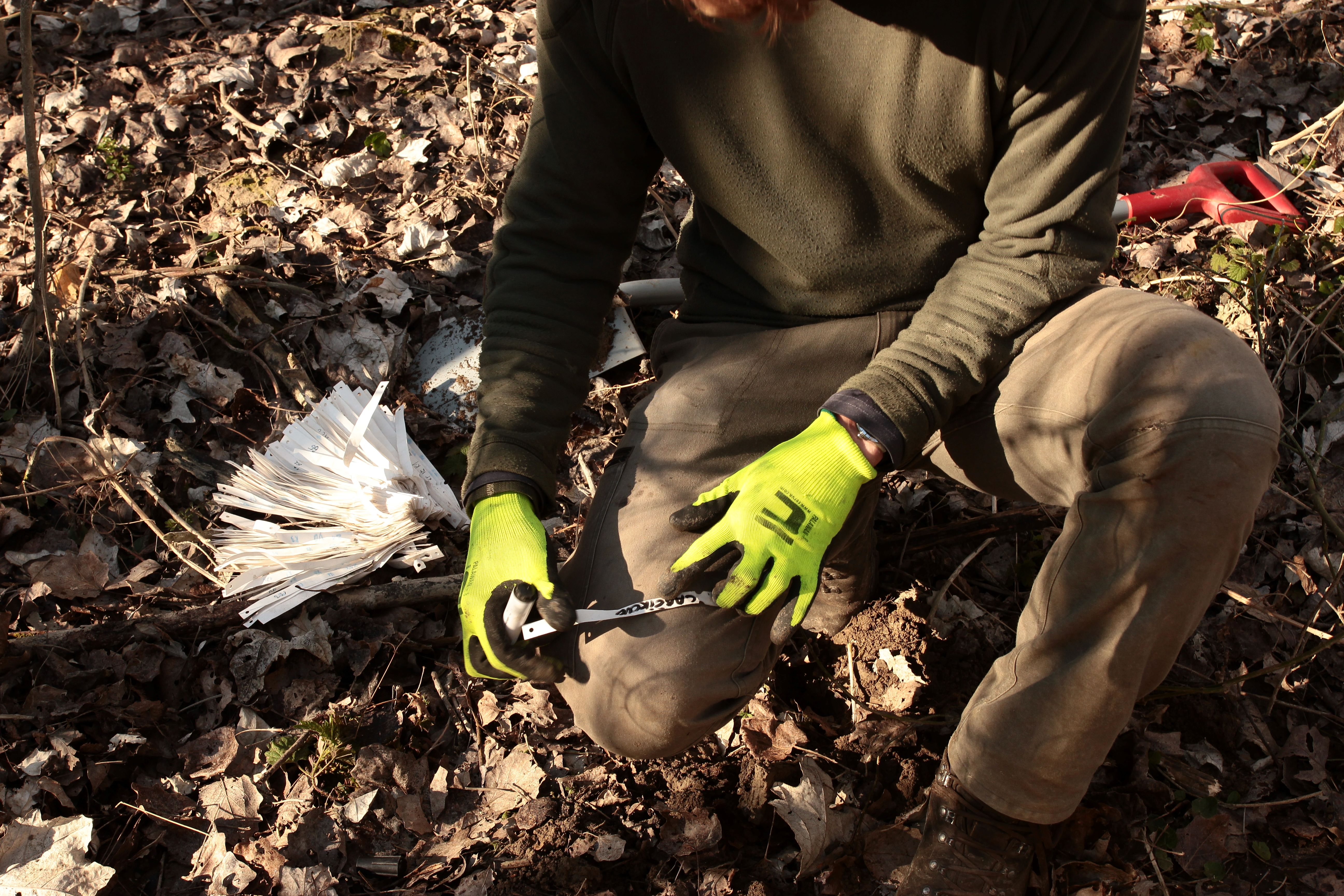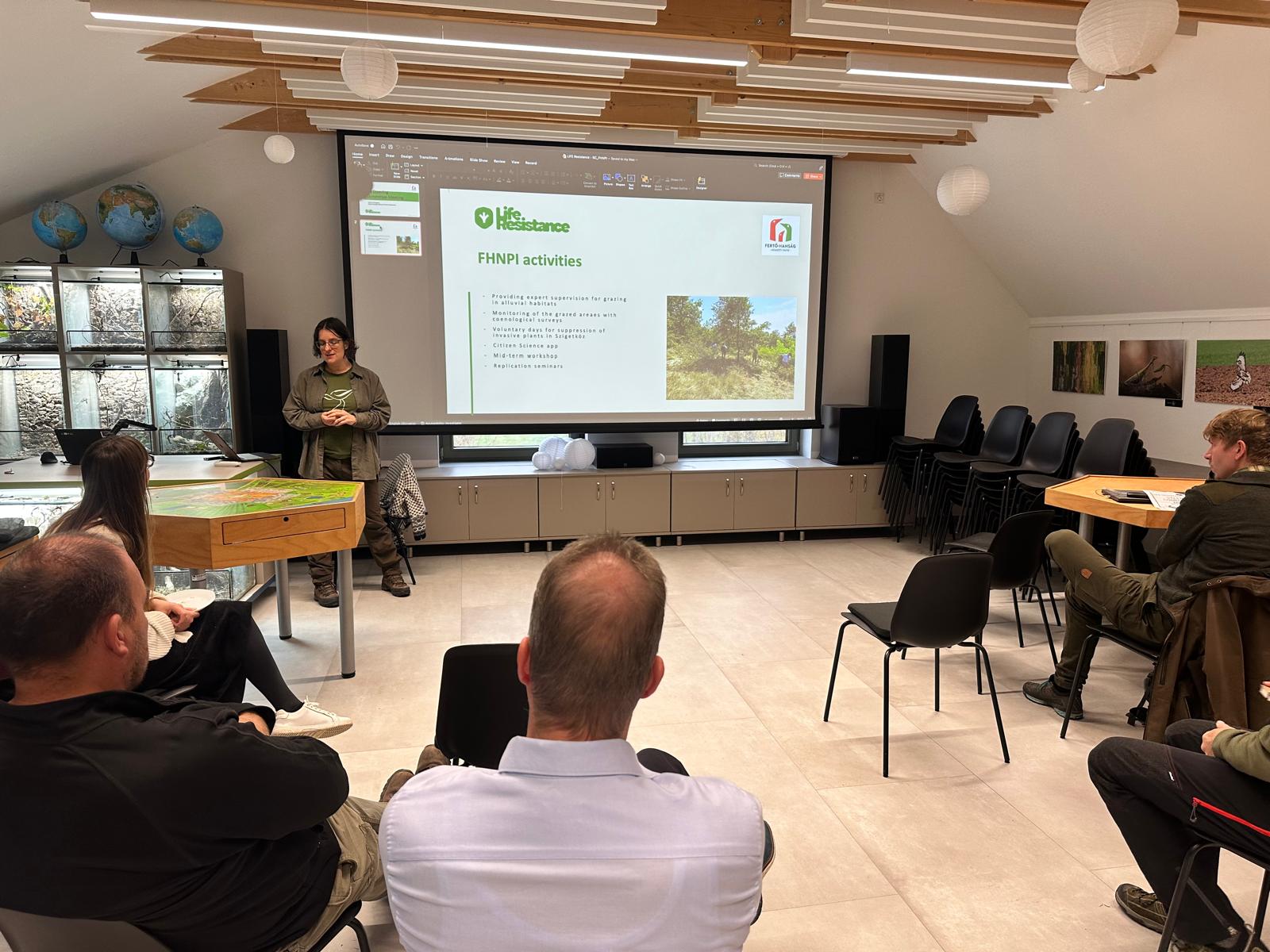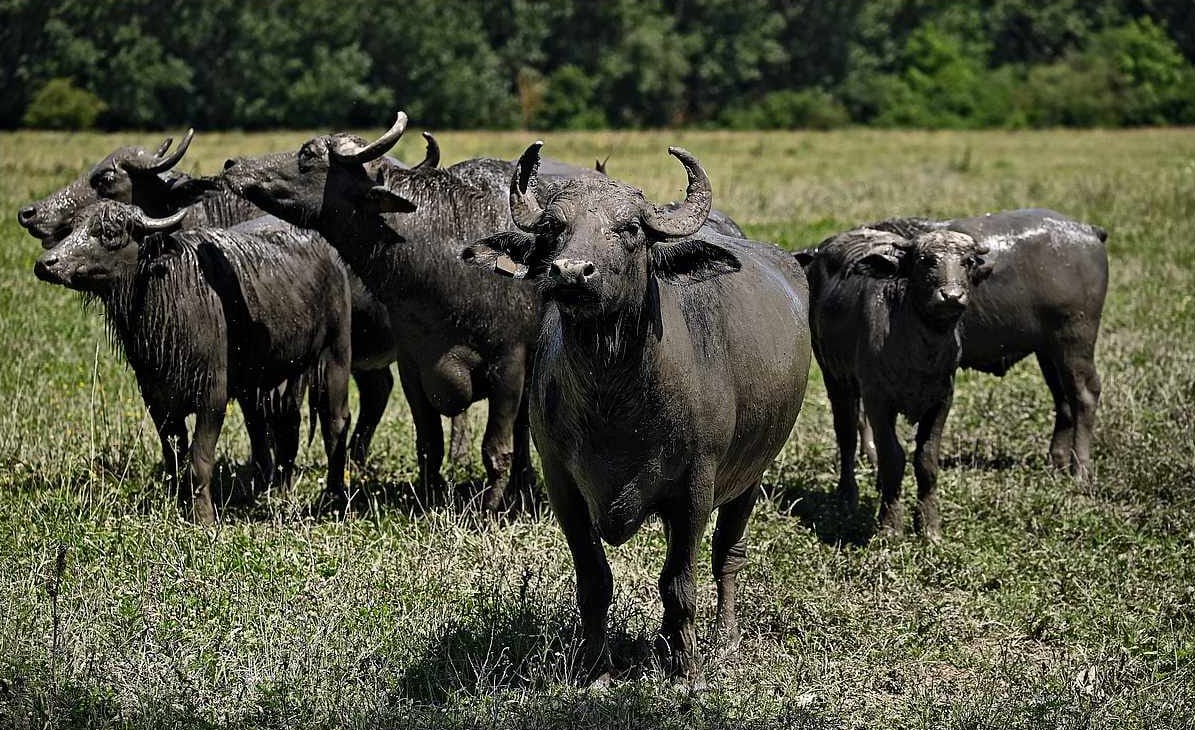Comprehensive restoration of Danube floodplain habitats and support for resistance to plant invasive alien species
The project aims at suppressing invasive plant species in Danube floodplain habitats through comprehensive measures. Naturally, the project is therefore a cooperation between organisations from Slovakia and Hungary. By restoring the water regime and the native plant species composition of the floodplain forests, as well as by reintroducing grazing to the project sites, we will create conditions unsuitable for invasive plants that suppress our native biodiversity. The project also includes the development and testing of software for early detection of invasive species stands and their spread using satellite and drone imagery. We will analyse the impact of restoration measures on living organisms through environmental DNA. The project also includes several innovative approaches, such as growing seedlings of native floodplain forest species with local ectomycorrhizal fungi that will be resistant to adverse conditions and can compete with invasive species; or removing the invasive tree of heaven (Ailanthus altissima) using its natural enemy, the fungus Verticillium sp. A wide range of educational activities are being carried out within the project to not only spread awareness of invasive species and the changes they cause, but also to make successful project measures available to experts and stakeholders so that the results can be replicated as far as possible in other locations and regions.

A Journey into Nature Conservation of Young Rangers has started.
The first meeting of the Young Ranger Club took place this autumn! During the meeting children engaged in hands-on nature conservation through the one-day event in the field. The children together with their teachers visited one of our project sites by boat where they took part in fun, age-appropriate biotope restoration tasks.

The sampling of ectomycorrhizal fungi has started
In the months of February and March we are collecting in selected stands of the Forest Management Units Čalovo, Gabčíkovo and Šamorín, located near the original channel of the Danube River, root samples for the investigation and subsequent testing of the application of mycorrhizae in the cultivation of seedlings that will be used for the restoration of natural forest stands.

Steering Committee Meeting Highlights
The Steering Committee of the LIFE Resistance Project convened for its first meeting on 19th of November, bringing together representatives from eight beneficiary organizations to discuss progress, achievements, and future plans.

We started grazing in Hungary
Our project partner, László Szomolányi, has introduced water buffalo grazing on a 12-hectare area in October 2024, marking a significant step towards habitat restoration and biodiversity enhancement.

The project LIFE Resistance has its visual identity
The project logo has an organic character. It symbolises life regardless of its form. The graphic design depicts a sign thrown into the water, which slowly dissolves and also refers to the rewetting of the sites. It does not have clear lines and the letters connect to each other.
Project name: Comprehensive restoration of Danube floodplain habitats and support for resistance to plant invasive alien species
Project scheme: LIFE Standart Action Projects (SAP), LIFE-2023-SAP-NAT – Nature and Biodiversity
Project acronym: NAT-SK-LIFE RESISTANCE
Project code: 101148377
Duration: 1.6.2024 – 30.9.2030
Budget: 6 465 129.60 € (67 % EU final contribution – 4 331 636.84 €)
Coordinating beneficiary:
BROZ – conservation association
Beneficiaries:
Szomolányi Lászlo – family farmer
Plant Science and Biodiversity Centre of Slovak Academy of Sciences (PSBCSAS)
National Forest Centre (NFC)
Water Research Institute (WRI)
Pisztráng Kör Egyesület (PKE)
Fertő-Hanság National park (FHNPD)
One of the most significant drivers of biodiversity loss is expansion of IAS. The project presents a comprehensive approach to support resistance of Danube alluvial habitats (*91E0, 6440, 3270, 91F0) towards IAS. 15 SCIs are targeted in Slovakia and Hungary. Altered water regime, intensive forestry, abandonment of traditional management, especially extensive grazing, initiates degradation of habitats and enables spreading of IAS. Through various complementary measures – 120 ha of wetlands and 20 ha of floodplain forest habitats will be restored and nature friendly grazing on 720 ha reintroduced. Using the synergy of above-mentioned actions together with mechanical, biological and chemical methods of IAS eradication, target IAS will be removed on 850 ha. Ecological conditions of the habitats will be improved, and their resistance to IAS increased by natural processes, with long-term and sustainable result. Water regime will be restored by flooding of natural depressions and gentle forestry methods will be tested and applied. Grazing, as a natural and traditional feature of alluvial habitats (incl. forests) will be reintroduced – to increase diversity of alluvial habitats, their resistance to IAS and promote dynamic processes of river. Various innovative methods are applied: comprehensive approach to IAS early IAS management, detection system using drone and satellite data build upon ESA projects, biological control of Ailanthus altissima, improvement of tree seedling survival by implementing usage of local mycorrhizal fungi, detected by DNA analyses and monitoring of project impact on fauna by eDNA metabarcoding methods. A complex set of awareness raising and dissemination actions is involved, covering all relevant target audience groups (stakeholders, experts, teachers, students, children and public) to support sustainability of the project results. Emphasis is given on increasing the replicability and improving policies and agro-envi scheme (CAP).
Alluvial forests with Alnus glutinosa and Fraxinus excelsior (habitat 91E0)
Alluvial forests, which include species like alder (Alnus glutinosa) and ash (Fraxinus excelsior), thrive in river floodplains and spring valleys.
These forests include softwood species like willow (Salix alba) and poplar (Populus nigra) and are essential for maintaining biodiversity. Historically, they covered much of the Pannonian lowlands but are now among the most endangered and fragmented habitats in Slovakia.
These habitats are crucial for many plant and animal species of European and national significance. In spring, they feature geophytes like snowdrops (Galanthus nivalis) and squills (Scilla vindobonensis). They also provide critical habitats for birds and bats.
The main threats to these forests include:
- Changes in water conditions
- Inappropriate forest management, including the planting of non-native species and intensive land use
- Infestation by invasive species
- Lack of grazing
Alluvial meadows of river valleys of the Cnidion dubii (habitat 6440)
These meadows are found in large lowland river floodplains that flood regularly but dry out in summer due to the continental climate. They are part of the Deschampsion cespitosae alliance and are influenced by the frequency, duration, and timing of floods, which supply essential nutrients.
Historically, these meadows have been important for high-quality hay production and are typically grazed or mowed once or twice a year. Dominant species include Alopecurus pratensis, Deschampsia cespitosa, Agrostis stolonifera, Poa palustris, and Carex vulpina. Tall sedge beds indicate a high groundwater table, even in summer, often found on low terraces and in depressions.
Alluvial meadows support several species of European interest, such as Cirsium brachycephalum, and nationally protected species like Viola pumila, Allium angulosum, and Oenanthe silaifolia. These meadows depend on proper agricultural management to maintain their ecological functions, including grazing and haymaking.
The primary threats to these habitats include:
- Intensive agricultural land use, including overgrazing and frequent haymaking with fertilizer application
- Infestation by invasive alien species
- Land-use abandonment, leading to overgrowth by woody species
- Lack of floods
Riparian mixed forests of Quercus robur, Ulmus laevis and Ulmus minor, Fraxinus excelsior or Fraxinus angustifolia, along the great rivers (habitat 91F0)
These hardwood forests, typically found along riverbeds, are subject to periodic flooding and fluctuations in the groundwater table. Dominant tree species include Fraxinus excelsior, F. angustifolia, Ulmus minor, U. laevis, and Quercus robur. In Slovakia, these forests occupy higher alluvial plains with soils classified as fluvisols and gleysols.
Historically, these forests covered large areas of the Pannonian lowlands before significant human settlement and agricultural development led to deforestation and fragmentation. Today, they are among the most altered and endangered ecosystems in Slovakia, facing threats from intensive forestry, water regime changes, and invasive species.
These habitats support a rich diversity of plant and animal species. In spring, they are characterized by geophytes like snowdrops (Galanthus nivalis) and squills (Scilla vindobonensis). The shrub layer is well-developed and species-rich, while the herb layer varies significantly between spring and summer, with low geophytes in spring and higher hemicryptophytes dominating later.
- The primary threats to these forests include:
- Intensive forest management
- Changes in hydrological conditions
- Infestation by invasive alien species
- Planting of non-native tree species and monocultures
Rivers with muddy banks with Chenopodion rubri pp and Bidention pp vegetation (habitat 3270)
These habitats are characterized by communities of short-lived species growing along riverbanks in muddy to sandy locations that are regularly flooded. They typically appear barren in spring and early summer, as vegetation develops later in the year. Under favourable conditions, species of European interest such as Apium repens and Lindernia procumbens, along with nationally protected species like Heleochloa alopecuroides and Dichostylis micheliana, can be found.
These habitats are essential for maintaining biodiversity and support various species that thrive in wet, muddy environments. They are particularly important for certain rare and protected plant species that depend on these specific conditions to survive.
The primary threats to these habitats include:
- Biological processes that may hinder plant growth
- Infestation by invasive alien species such as Aster lanceolatus, Amaranthus powellii, Ambrosia artemisiifolia, Bidens frondosa, Helianthus tuberosus, and Stenactis annua
- Inconsistent flooding patterns, either lack of floods or frequent overflooding
Reintroduction of Grazing
Grazing will be reintroduced to alluvial habitats to restore biodiversity and control invasive species, a method historically used but abandoned due to socio-economic changes. Grazing prevents succession, promotes a variety of microhabitats, and helps maintain alluvial meadows and floodplain forests by suppressing invasive species. In the initial years, grazing intensity will be higher to effectively suppress non-native species, with adjustments made over time to align with the area’s recovery rate. In Hungary, Szomolányi Lászlo in cooperation with Fertő-Hanság National park will manage the grazing in SCI Szigetköz. In Slovakia, BROZ and local farmers will handle various sites. Additional restoration measures will be implemented in long-term abandoned areas, including mulching tall weed vegetation, removing biomass, milling overgrown woody vegetation. The innovative use of GPS collars for virtual fencing will manage grazing patterns in difficult terrains, reduce human disturbance, and prevent overgrazing.
Complex mapping, early detection and removal of IAS
A software extension of NaturaSat called the “Complex Mapping and Early Detection and Rapid Response System” (CM&ED&RR System) will be created, consisting of Comprehensive Mapping (CM) and the Early Detection and Rapid Response System (ED&RR System). CM will refine the mapping of IAS occurence by detecting habitat changes and new types formed by IAS using satellite (Sentinel) and drone data. Initially, NaturaSat will semi-automatically segment IAS-dominated areas, verified in the field for software calibration. Identified polygons will be stored in a database and monitored annually, with significant changes triggering automatic alerts to local authorities.
The ED&RR System will identify vulnerable areas based on environmental factors supporting invasion. Using NaturaSat’s remote sensing tools, it will track spreading pathways, habitats prone to invasion, low-diversity areas, low vegetation cover, and poor health conditions (NDVI). The CM&ED&RR System will be replicated among stakeholders and presented at EU conferences.
Complementing natural suppression methods in previously mentioned actions, this action will focuse on aggressive IAS where natural methods are infeasible. Best practices and innovative methods, like using Verticillium nonalfalfae for Ailanthus altissima, will be tested.
Awareness raising, dissemination of results and stakeholder cooperation
The activities aim to increase awareness of invasive alien plant species (IAS) and promote nature-based measures to enhance biotope resilience. Key activities include project communication through branding, media outreach, and a dedicated website updated regularly in multiple languages. Stakeholder engagement involves personal meetings, distribution of promotional materials, and organizing events like volunteer activities, summer camps, and study tours. Long-term awareness efforts include a documentary, interactive exhibitions, and information panels. The initiative also supports farmers through a platform for sustainable farming and eco-tourism. Finally, a citizen science initiative encourages public participation in IAS monitoring.
Monitoring of project impact
Monitoring efforts across various facets of the project are extensive and integrated. All beneficiaries collaborate closely to ensure comprehensive assessment and reporting. PSBCSAS and FHNPI lead habitat monitoring, assessing conservation action impacts on habitats. They establish baseline data, conduct phytosociological surveys, and track vegetation response, focusing on species diversity and invasive species. Data is shared with national databases and authorities. Wetland Restoration Monitoring will be done by WRI and BROZ. Long-term monitoring includes flood strength and water level data, supported by meteorological stations from prior LIFE projects. All beneficiaries will contribute to conduct regular KPI monitoring to assess project impacts on nature, biodiversity, and socio-economic factors. PSBCSAS evaluates fauna biodiversity using DNA metabarcoding (analysis of eDNA), comparing pre- and post-restoration conditions. PKE and BROZ evaluate dissemination effectiveness through quantitative and qualitative methods, tracking participant numbers, media coverage, and public feedback to refine strategies continuously.
Sustainability, replication, and exploitation of project results
The project aims to ensure broad dissemination, replication, and long-term sustainability of outcomes across various sectors and regions. Key tasks include developing and promoting best practices in restoring natural conditions, systematic invasive species removal, innovative grazing methods, citizen science involvement, nature-friendly alluvial forest restoration, biological control of Ailanthus altissima, user-friendly mapping systems, early detection, and introducing DNA barcoding for biodiversity assessment. Additionally, the project focuses on influencing policies and legislation related to invasive species management, networking through workshops, seminars, and conferences, engaging with public and private sectors, hosting a final international conference, and developing a “RESISTANT LANDSCAPE” catalogue of measures.
project manager
RNDr. Michaela Kalivodová, PhD.
kalivodova(at)broz.sk
+421 917 569 979





